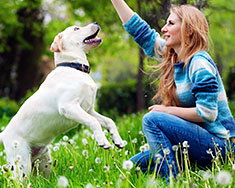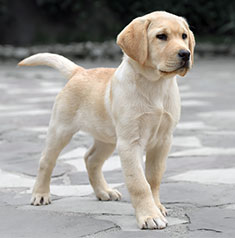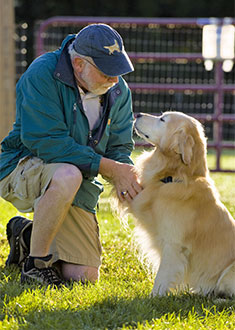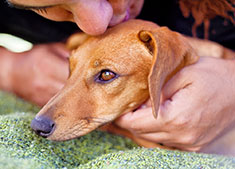How to Talk to Your Dog

Communication is the first step towards establishing a trusting relationship with your dog. This opens the path for obedience, calm walks, simple and complex tricks, and playtime. Improper communication can damage the relationship between a person and their dog. Dogs feel confused and anxious when they cannot comprehend why they're being disciplined, commanded, or shepherded around.
It can be frustrating when we don't understand our dogs, or they don't understand what we want from them. This can make teaching tricks and dealing with overexcitement and misbehaving even more challenging for people. And if the owner is frustrated, or takes their frustration out on the animal, the dog will follow suit and misbehave further in its insecurity.

Reading Dog Behavior
Dogs are highly intelligent animals, but they're not people. We can't expect them to learn our language. Instead, if we want them to understand us, we have to first understand them. Communicating with dogs paves the path to a strong partnership.
-
Calm: Quiet, slow wagging tail, slow blinks, lying down, curling up, lounging, open mouth, lolling tongue.
When calm, the dog feels safe and trusts those around it. A calm dog is responsive and possesses no danger of aggressing. To reinforce calm behavior, offer attention and treats while the dog is in a relaxed state of mind.
-
Playful: Bowing, tail wagging freely, open mouth like a grin, excited bark, movement, running, spinning, hopping on front paws, pinned ears.
The dog wants to initiate play. Games are a wonderful way to establish a positive relationship. Playfulness should be encouraged. However, if too much energy builds up, the dog may become overexcited.
-
Excited: Restless pacing, fast walking, jumping, spinning, dancing on paws, barking, destructive behavior, nipping, sharp barks, whining, yawning, pinned ears.
An excited dog has a great deal of energy and needs to express it or calm down. If the energy cannot be released, the dog may become destructive. Exercise and regular walks will calm overexcitement.
Shouting and frustration will only serve to increase the dog's energy levels. Time-outs in the crate will frustrate the dog, keeping the excitement from releasing. If a dog is too eager, wait until they settle down before rewarding with treats, food, affection, and walks. Otherwise, the excitable behavior is reinforced.
-
Scared/Nervous: Arched body, crouching, cowering, shaking, ears back, worried eyes, licking nose, tail between legs, yawning, wary of surroundings and others, scampering.
A nervous dog does not feel safe and secure. Dogs will become nervous when they feel intimidated or mistrustful. A dog that feels threatened is more likely to bolt or bite.
Fear is transferred to a dog from a scared owner, so it's essential to first be calm and confident when handling a nervous animal. Continue on as though nothing as wrong, and the dog will see that there's nothing to be afraid of.
If a dog is wary of you, then its trust must be earned. Remain calm, refrain from offering affection, and don't feel sorry or guilty for the dog. Doing so will only feed into his insecurity. Sit near the dog and slowly wave some food around, without offering it. Allow the dog to come to you. Once its by your side and comfortable, reward the dog with the food and offer gentle affection and kind words.
-
Alert: Head raised, ears up, tail up, tail stiffly wagging, scoping the area, closed mouth, fixed gaze, rigid posture.
An alert dog is on the lookout. Either he's wanting to snatch a toy he's fixated on, caught sight of another animal, or keeping an eye out for danger. In some situations, alertness can escalate into aggression. If the dog is on edge, it may feel inclined to attack another dog that approaches.
It's important not to let alertness escalate to aggression. If a dog is fixating on a toy, small animal, another dog, or a person, a distraction will break its intense concentration. Distractions come in the form of food lures, a high pitched vocal sound, or a quick and gentle leash jerk if the dog still doesn't respond. When walking, suddenly reversing direction will snap the dog's focus and show it that it doesn't get to proceed when it isn't calm. Dragging, shouting, kicking, and prong collars will not break an alert dog from fixation and leash pulling. These methods will only cause unnecessary harm.
-
Aggressive: Rigid body, bristled fur, low head, wide eyes, lip curling, growling, snarling, snapping, barking, ears forward.
Indicates the dog is either defending himself out of fear, or confidently attempting to assert itself by correcting behavior it does not like or forcing its target into submission. Aggressive dogs are moments away from biting. Bites can range from light corrections to vicious mauls. It is essential to curb aggressive behavior, both for the sake of the dog and surrounding people and animals.
When dealing with aggression problems, it's important to first understand the underlying cause. Determine if the dog is scared or confident. If the dog is scared, it needs to be calmed in order to earn its trust. Some dogs, when frightened, experience situational aggression. Once the root cause of the fear is understood and dealt with, the dog will have no need to aggress and the incidents will stop repeating. A dog is less likely to feel afraid when it trusts its owner and looks to them for direction.
A confident aggressive dog is a dominant dog. Leadership, trust, and control must be established to prevent the aggressive misbehavior from continuing. Methods for curbing aggression depend on a number of factors, from how serious the aggression is, to the personality and breed of the dog.


Communicating with Dogs
Dogs don't understand the art of speech. Instead, we must speak to them using body language and voice pitch. Dogs are constantly communicating with signals and physical cues. Once these cues are understood, it's possible to talk with a dog on their level.
-
"Play time!": Getting low to the ground, towards the dog's level, either on your knees or bending over. Slapping the floor or your legs. Speaking in a high pitched, excited voice.
Playtime strengthens the relationship between a dog and its owner. Calmness is important, but so is letting loose once in awhile and having a good time. Playing, no matter how vigorously, is not a proper substitute for exercise.
"Let's calm down.": Disengage, stand up, don't give any attention. Look away, be calm, yawn, sigh, blink slowly, act aloof and disinterested.
Letting an excited dog be is an effective method for calming it when its energy level rises too high. The dog understands that, when its behavior is too energetic, it won't receive treats or attention.
"The fun's over here!": Speak in an encouraging, high pitched voice. Back up, shuffle, clap, slap your thighs.
This creates a fun state of mind which encourages and reinforces recall. For a successful relationship, the dog should enjoy running up to and being near its owner.
 Earn trust and develop a life long bond with your dog.
Earn trust and develop a life long bond with your dog."I trust you/I'm not a threat.": Speak in a low, soft voice. Remain calm. Keep a low position, either sitting, on your back, or on your side. Massage the underside of the dog, such as the belly, front neck, and jaw. Avert eyes and don't make contact.
Calm, approachable attention will earn trust, build confidence, and strengthen the relationship with a dog. Coaxing a wary dog takes a great deal of time and patience. Frustration and irritation will scare the shy animal away.
"I'm calm and confident.": Maintain an erect posture, back straight, head up, strong, but not tense. Tenseness betrays uncertainty, so remain loose and easy going. Resist giving affection at this time. If walking, don't look at the dog, but straight ahead towards the goal.
Confidence shows that you're a worthy leader who knows what they're doing. This is essential when building a relationship and teaching dogs proper behavior and tricks.
-
"I'm nervous.": Locked body, uncertainly watching the dog, tensely holding leash, flinching away from the dog, anxious voice.
A dog will not trust a nervous leader, and will instead attempt to take over the role as head of the household. Showing nervous behavior threatens the balance between owner and pet, and leaves an opening for misbehavior.
Remaining calm, even during a tense or stressful time, is important for a dog's state of mind. If a dog sees that its owner is nervous or frightened, it won't understand abstract reasons, such as financial troubles, only that there's a reason to be afraid. This causes the dog to go on the alert, possibly leading to aggression. The animal may feel the need to protect its owner from whatever danger is present, be it the neighbor's cat or the mailman.
"I'm angry/I'm a threat.": Shouting, harsh noises, striking a dog, hovering over a dog, herding a dog into a corner or enclosed space, sticking your face in a dog's face, overbearing eye contact, frustration, anger, attempting to force cooperation.
Showing aggression towards a dog will either inspire fear, damaging the trust and relationship of animal and owner, or result in a counter offense. A true leader, and a proper owner, doesn't depend upon the use of intimidation and pain to get their pack under control. Resorting to threatening behavior or violence will only result in a traumatized dog or a nasty bite.
Understanding dog behavior and communication is a tool designed to establish and reinforce positive relationships between owners and pets. Reading dog behavior and body language is the first step towards effective and rewarding teamwork. It's important that dogs behave and respond to what their owners need them to do, but the trust and friendship between partners should always take priority.
Read more about your Dog's Emotions Here.
Doggies Den: Latest Articles
 Homemade Thanksgiving Treats for Your Dog
Homemade Thanksgiving Treats for Your Dog
NUTRITION We all want to include our dogs in our holiday celebrations, but hopefully, you're aware that sharing table scraps with your dog isn't always the best idea.
 Keeping Your Dog Safe during the Summer Months
Keeping Your Dog Safe during the Summer Months
HEALTH Summer is coming on fast, so it’s time to plan how you will keep your dog safe and healthy through the lazy, carefree, warm days.
 Vaccination Time Again-Keeping Your Puppy Healthy
Vaccination Time Again-Keeping Your Puppy Healthy
DOG HEALTH So you have your new puppy picked out. There are quite a few shots, treatments and examinations that will keep the newest member of your family healthy.
 Canine Thanksgiving Feast
Canine Thanksgiving Feast
NUTRITION With the wide variety of food at Thanksgiving dinner, chances are you'll want to give your dog something special, too. If you're contemplating what to feed your dog for the holiday, here is a guide to a great Canine Thanksgiving Feast.
 Dog Walking Tips Every Owner Should Know
Dog Walking Tips Every Owner Should Know
DOG FUN Walking your dog is not only crucial to keeping him healthy and happy, it strengthens the bond between your canine friend and his caregiver. There are a lot of obstacles out there. Don’t forget these simple tips to keep your walk fun and safe in the outside world.
 The Benefits of Physiotherapy for your Dog
The Benefits of Physiotherapy for your Dog
HEALTH The same techniques that physiotherapists use to treat a variety of injuries and conditions in humans have been adapted to suit animals with great success. Family pets, show dogs, and working dogs can all benefit greatly from physiotherapy. Dogs whose activities involve a lot of agility are especially susceptible to the types of problems that physiotherapy can address.
 The Decision- Adding a Dog to Your Family
The Decision- Adding a Dog to Your Family
FIRST TIME OWNERSBringing a dog into your family is a decision where many people don’t realize it’s magnitude until after they have the dog. There are a number of things that you need to research before you decide to purchase a dog, and it starts right in your own home.
 Bringing Your Dog Into Your New Baby's Life
Bringing Your Dog Into Your New Baby's Life
HEALTH Many believe that a dog and a new baby cannot happily coexist, so therefore the dog has to go. This is not necessarily the case.  A new baby does not mean you have to abandon your dog.

Doggies Den:
Most Popular Articles

Dog Pregnancy Symptoms
HEALTHIf you suspect your dog might be pregnant, check out part one in this series on pregnant dogs, where we cover pregnant dog symptoms.

Dog Birth
HEALTHIn the third article of our dog pregnancy series, we look at the wonderful, but messy, process of bringing newborn puppies into the world.

Indoor Dog Potties
DOG PRODUCTSIt's been a long day at work. You were so busy, you didn't even take time to eat a sandwich, let alone run home to let your dog out. You're on your way home, knowing the poor dog is crossing his or her legs by now, when your car breaks down, delaying you even further. Can't somebody make this easier?

Your Dog’s Digestive System
PHYSIOLOGYEver wonder why your dog eats so fast? Or why he eats gross things? Or why he gets sick to his stomach? Or why his waste stinks so bad? Some of these things are normal, some are not.

Canine Respiratory System
BREATHINGThe basic function of your dog's respiratory system is to bring oxygen in to and remove carbon dioxide from the body. Knowing the symptoms of respiratory diseases can help you help your stay healthy.

Shelter Dog Adoption Tips for Success
ADOPTION Are you intimidated by the prospect of "rescuing" a dog from a shelter? One reason that you may be wary of adopting a dog from a shelter is not knowing how to choose. Adopting a dog from a shelter can be a rewarding process, if you're prepared to do a reasonable amount of research.

Canine Urinary Tract Infections
SYMPTOMS AND TREATMENTDoes your dog seem to be having trouble relieving his or her bladder? Learn how to recognize the signs of urinary tract infections and how to treat them before they spread.

What to do for Dog Diarrhea
SYMPTOMS AND REMEDIESIf you have dogs in your house for any length of time, you have likely experienced at least one bout of dog diarrhea. Beyond the pain in the tuckus involved in cleaning up the mess, you should know what causes diarrhea, and when it's important to see the vet.

What to do for a Dog Bite
DOG BEHAVIOR Getting bitten by a dog can be scary, and you may be tempted to run around in circles for a while, trying to figure out what to do. Here's our guide to help you manage the situation.

Top Ten Tips for Living with a Senior Dog
DOG HEALTH Bringing home a new puppy is so exciting, but it doesn’t take all that long for your exuberant puppy to grow into a senior dog who may have special needs. Here are the doggies.com top ten tips for taking care of your companion who has been with you through so much.
